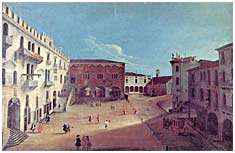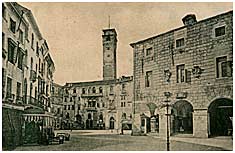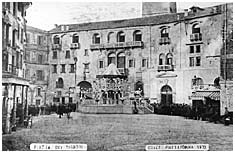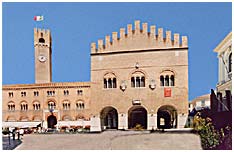| THE PIAZZA DEI SIGNORI IN TREVISO |
| |
The Palazzo della Prefettura (Prefecture Palace), the Palazzo dei Trecento and
Cal Maggior (the main porticoed street) frame the most important square in Treviso.
The Palazzo della Signoria, called "Palazzo della Prefettura" (Prefecture Palace) today, in Treviso was equivalent
to half of that is at first.
The name of the neighbouring Piazza dei Signori comes back closeness of Palazzo della Signoria according
to the history and not as we might think because it was dedicated to the richest classes. |
| |
|
It was raised when the rooms used as offices and
located near the Palazzo dei Trecento, became inadequate to take in the Municipal Administration Offices.
The Palace was used as residence of Podestà in Treviso, he had to be neither Trevisan nor to come from
neighbouring countries subjugated by tyranny. He was lacking in own house and thus he was going usually to live in
town with all its entourage and he occupied the houses next to Palazzo dei Trecento; these houses were
removed from rightful owners. |
 |
 Medoro Coghetto (1707-1793)
Medoro Coghetto (1707-1793)
Piazza della Signoria
Treviso, Museo Civico L. Bailo |
| |
|
The building was almost ended in 1217 when the
first Domus Comunis, located in Piazza Duomo, was damaged.
The look of the Palazzo della Prefettura (Prefecture Palace) changed many times during Treviso history;
its fašade, overlooking the square, is portrayed in a canvas by Medoro Coghetto in the
second half of 18th century: it had two wide entry arches and an impressive marble staircase which allowed
to enter the close Palazzo dei Trecento. |
| |
|

Piazza dei Signori in 1870 |

Piazza dei Signori a Treviso con la piattaforma eretta per il carnevale,
anno 1873, FAST - Foto Archivio Storico Trevigiano, Fondo Fini,
n. immagine: F 78 |
| |

Piazza dei Signori today |
 |
The Torre Civica (Municipal Bell Tower) was raised behind the
Palazzo della Prefettura (Prefecture Palace) in 1218, it wasn’t fastened to the remaining part of municipal
buildings in the beginning. The palace was enlarged after about fifty years and so the tower was joined to
Prefecture Complex. The Municipal Tower had a bulb roof and some battlements at first, the second were removed in the first years
of 17th century, while the bulb roof didn’t appear in the beginning of 20th century, it was replaced by
the battlements which characterize the tower till today. |
|
| |
| |
| |
|
| |


